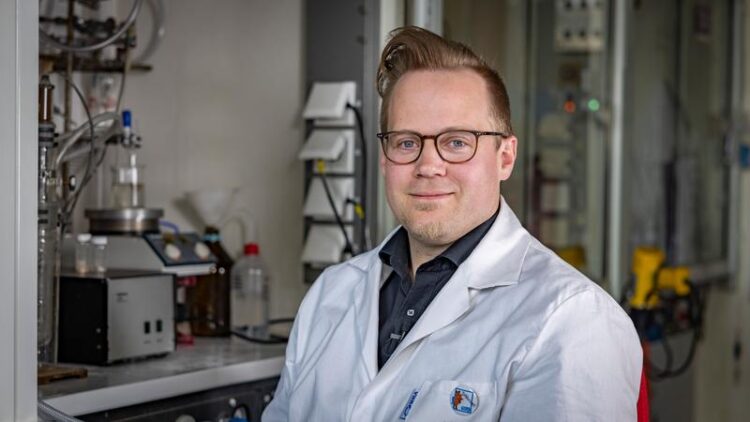Fundamental Problem Solved

Prof. Dr. Johannes Teichert from Chemnitz University of Technology demonstrated neutral homoaromatic compounds for the first time.
Photo: Jacob Müller / Chemnitz University Technology
Chemists from Chemnitz prepared long searched Chemical Compound for the First Time.
High-profile publication in the journal Nature Chemistry: Prof. Dr. Johannes Teichert and his team from Chemnitz University of Technology successfully show the existence of the neutral homoaromatic compound.
In a recent issue of the renowned and highly cited international journal Nature Chemistry, Prof. Dr. Johannes Teichert, head of the Professorship of Organic Chemistry at Chemnitz University of Technology, his research assistant Trung Tran Ngoc, and other contributors report on a so-called “neutral homoaromatic compound”.
The findings are a milestone for organic chemistry, as chemists had only proposed the existence of this class of molecules for more than 70 years. Practical evidence had been lacking until now.
“With this groundbreaking discovery, we were able to solve a fundamental problem in chemistry and demonstrate for the first time, that the long-assumed but never prepared neutral homoaromatic compounds actually exist in organic chemistry”, says Teichert. “This is nothing less than a breakthrough for organic chemistry – also because we have characterized these compounds for the first time with their individual properties”, Teichert continues.
The homoaromatic molecules produced by Teichert and his team can, for example, be used as “replacement building blocks” for classical aromatic molecules. This opens up entirely new combination possibilities and approaches for developing new materials or active substances in medicine.
First stable synthesis and targeted modification
While classical aromatic molecules are characterized by their cyclic structure and a circular movement of electrons, this ring is interrupted in homoaromatic compounds.
However, if the reactive ends of the molecule are held in an exact geometry, the circular movement of the electrons is maintained even without a “real” bond. This connection of molecules beyond a classical chemical bond is a special property of the homoaromatic compounds produced by Teichert and his team. “For the first time, we can now investigate and systematically modify the molecular interactions within the homoaromatic compounds,” adds Teichert’s assistant Trung Tran Ngoc. “The stability of the compound allows us to intensively explore and better understand the concept of homoaromaticity,” Teichert adds.
New photochemical switches enable new research paths, e.g., in biomedicine
With the discovery of this new form of chemical compounds, a new type of photochemical switch is also introduced. So-called “photoswitches” play an important role in medicine and biomedicine, among other fields. These switches can, for example, be used to specifically stimulate active substances in the human body from the outside using light, activating and investigating their effects on-site.
Publication: Tran Ngoc, T., Grabicki, N., Irran, E. et al. Photoswitching neutral homoaromatic hydrocarbons. Nat. Chem. 15, 377–385 (2023).
DOI: https://doi.org/10.1038/s41557-022-01121-w
For more information, please contact Prof. Dr. Johannes Teichert, tel. +49 371 531-33715, e-mail johannes.teichert@chemie.tu-chemnitz.de
(Article: Matthias Fejes / Translation: Brent Benofsky)
Media Contact
All latest news from the category: Life Sciences and Chemistry
Articles and reports from the Life Sciences and chemistry area deal with applied and basic research into modern biology, chemistry and human medicine.
Valuable information can be found on a range of life sciences fields including bacteriology, biochemistry, bionics, bioinformatics, biophysics, biotechnology, genetics, geobotany, human biology, marine biology, microbiology, molecular biology, cellular biology, zoology, bioinorganic chemistry, microchemistry and environmental chemistry.
Newest articles

Sea slugs inspire highly stretchable biomedical sensor
USC Viterbi School of Engineering researcher Hangbo Zhao presents findings on highly stretchable and customizable microneedles for application in fields including neuroscience, tissue engineering, and wearable bioelectronics. The revolution in…

Twisting and binding matter waves with photons in a cavity
Precisely measuring the energy states of individual atoms has been a historical challenge for physicists due to atomic recoil. When an atom interacts with a photon, the atom “recoils” in…

Nanotubes, nanoparticles, and antibodies detect tiny amounts of fentanyl
New sensor is six orders of magnitude more sensitive than the next best thing. A research team at Pitt led by Alexander Star, a chemistry professor in the Kenneth P. Dietrich…





















